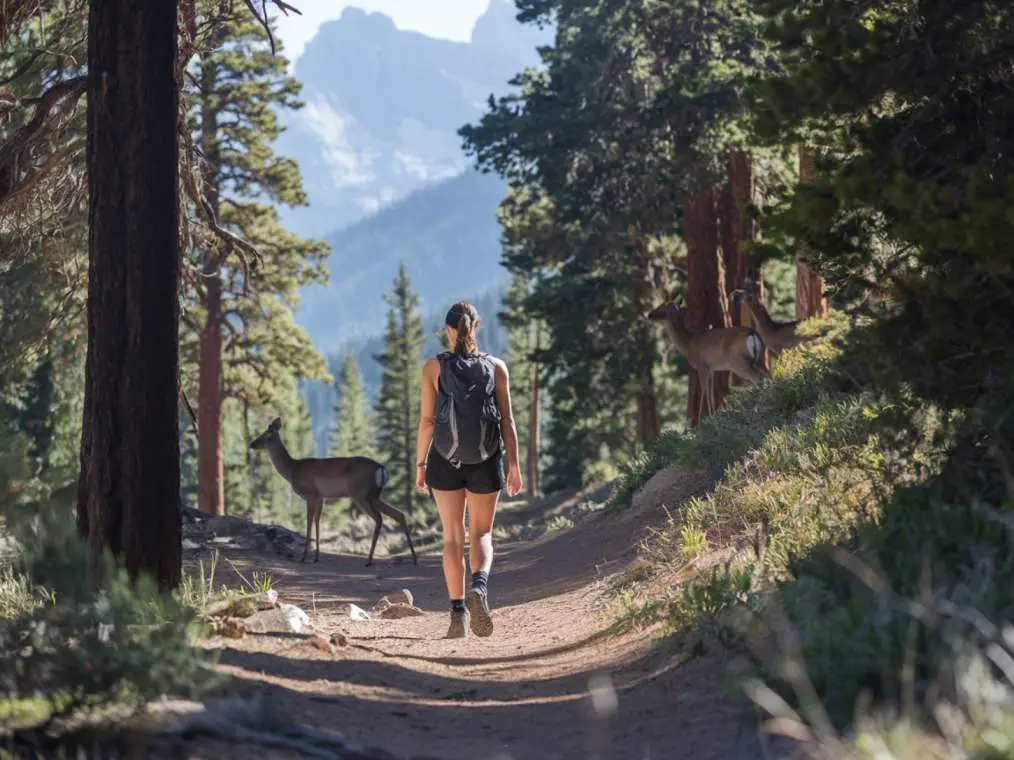Going solo in America’s national parks is an exciting journey for women. These places are safe, beautiful, and great for personal growth. You can see towering trees in Yosemite or explore underwater in Biscayne.
For solo female travelers, knowing how to stay safe is key. With the right prep, women can explore trails, camp under the stars, and make memories. National parks have rangers, educational programs, and a community of nature lovers.
Yosemite National Park is a top spot for solo female travelers. It has cozy heated tents at Curry Village. The park’s trails are for all, offering stunning views from places like Glacier Point and Tunnel View.
This post may include affiliate links, meaning I could earn a small commission if you make a purchase through them—at no additional cost to you. Your support helps me continue creating helpful content. For full details, please read my affiliate disclosure here.
Key Takeaways
- National parks offer a safe and supportive environment for solo female travelers
- Proper planning and research are essential for a successful solo adventure
- Yosemite provides diverse accommodations and activities for solo travelers
- Safety precautions are crucial for navigating potential risks in national parks
- Various parks offer unique experiences, from underwater exploration to cave adventures
- Ranger-led programs and guided tours enhance the solo travel experience
Why National Parks are Ideal for Solo Female Travelers
National parks are a great choice for solo female adventurers. With 63 parks across the U.S., they offer a wide range of experiences. From remote wilderness to easy-to-reach landscapes, there’s something for every solo traveler.
Safety Considerations
Safety is a big concern for solo female travelers in national parks. Parks use timed-entry systems and reservations to keep visitor numbers down. This, along with ranger presence, makes solo adventures safer. It’s important for solo travelers to carry a first-aid kit and bear spray in some areas.
Abundant Resources and Support
National parks have lots of resources for solo travelers. Visitor centers give out free maps, guides, and info on trails and wildlife. Rangers are always there to offer tips and advice. The America the Beautiful Pass, at $80, lets you visit all 63 major parks, making it a good deal for frequent visitors.
Opportunities for Personal Growth
Solo travel in national parks helps women grow personally. These places let women explore at their own pace and challenge themselves. Parks also offer guided walks and talks, making solo travel even better. Don’t forget to take lots of photos to remember your adventures.
Advantages of Solo Travel in National Parks
Traveling solo in national parks is a world of possibilities. As a 34-year-old African American woman with a visible disability, I’ve found joy in solo hiking. My chronic illness makes group outings hard, but solo trips give me freedom.
National parks have something for everyone. You can enjoy scenic drives or tough hikes, no matter your skill level. The trails are well-kept, and signs are clear, helping even beginners navigate.
Learning to be spontaneous is key for solo travel. I can change my plans anytime, leading to new discoveries and friends. This freedom has made my trips unforgettable.
- Freedom to explore at your own pace
- Opportunities for personal growth and reflection
- Chance to meet like-minded travelers
- Participation in ranger-led activities
Solo travel has made me more confident. I trust myself and my choices. Hiking alone has taught me to rely on myself, boosting my self-assurance in all areas of life.
Essential Gear for Solo Female Adventurers
Going on outdoor adventures alone as a woman means you need to be ready. The right gear keeps you safe and makes your trips fun. Here’s what you should pack for your hikes.
Safety Equipment
Important Safety Items for Traveling Alone in the Park – Quick Reference:
- Personal Safety Alarm: A loud alarm that will get people’s attention and scare away threats
- A first aid kit has basic medical supplies that can be used to treat small injuries and illnesses.
- Tactical Safety Pen: A writing tool and a self-defense tool in one
- Bear Spray is a strong deterrent spray that works on wild animals that are mean.
- Carbon Monoxide Detector: A portable tool for finding dangerous CO gas while camping
- Need Help Satellite Communicator: A way to talk to people in places where cell service isn’t available
- Headlamp: For night guidance, you need hands-free lighting.
- Multi-tool: A device that can fix things and be used in an emergency.
- Emergency whistle: a simple, effective way to let people know you need help
- Water Filtration System—Makes sure that natural water sources provide safe drinking water
- Emergency Shelter: A small place to stay dry in case of bad weather
- Power banks are portable chargers that keep electronics charged.
- Navigation tools, like maps and a clock, help you find your way.
- Weather Protection: Things you need in case the weather changes quickly
Camping and Hiking Essentials
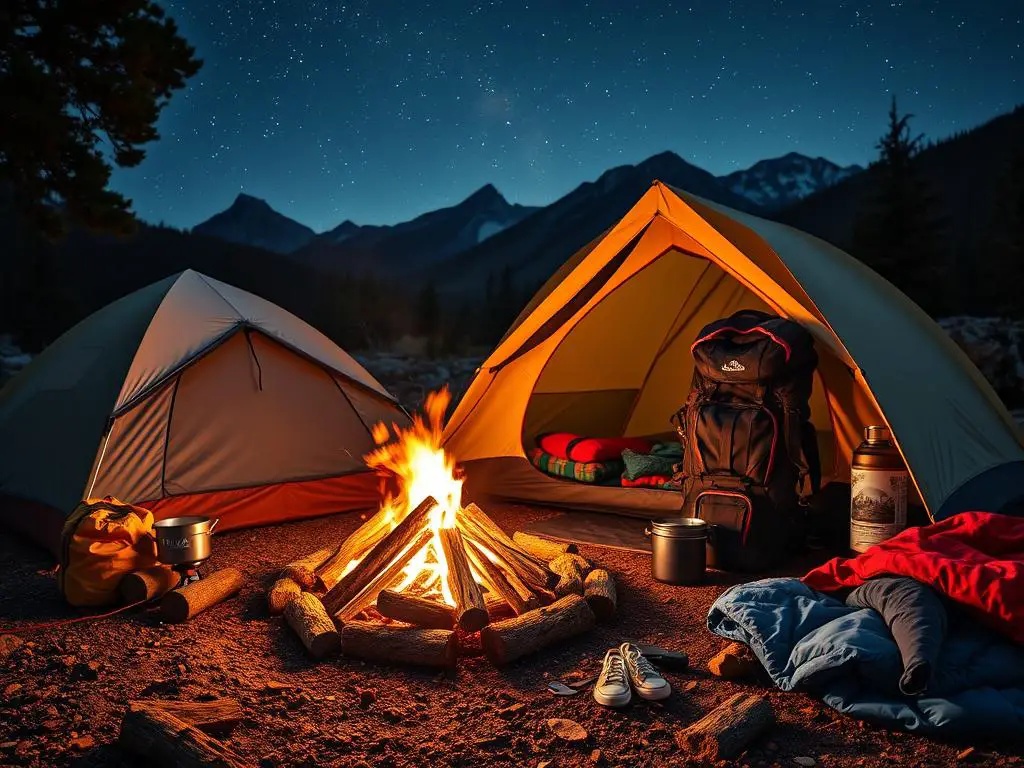
Essential Camping Gear for Solo National Park Adventures:
- Shelter & Sleep System
- 3-Season Tent – Weather-resistant shelter suitable for most conditions
- Sleeping Bag – Temperature rated for your destination and season
- Sleeping Pad – Insulation from ground and comfort for rest
- Camp Pillow – Compact pillow for proper sleep support
- Tent Footprint – Ground protection for tent longevity
- Clothing Layers
- Base Layer – Moisture-wicking thermal wear
- Mid Layer – Insulating fleece or wool
- Outer Shell – Waterproof/windproof jacket and pants
- Hiking Boots – Sturdy, waterproof footwear with ankle support
- Camp Shoes – Light, comfortable footwear for camp
- Wool Socks – Multiple pairs for moisture management
- Quick-dry Underwear – Prevents chafing and moisture buildup
- Sun Hat/Warm Hat – Protection from elements
- Gloves – Both thin liner and waterproof options
- Tools & Equipment
- Multi-tool Knife – For repairs, food prep, and utility
- Water Filter – Reliable water purification system
- Portable Charger – High-capacity power bank for devices
- Trekking Poles – Support and stability on trails
- Rope/Paracord – Multiple uses from clothesline to emergencies
- Firestarter – Waterproof matches and lighter
- Duct Tape – Repairs and multiple uses
- Headlamp – Hands-free lighting
- Camp Stove – Lightweight cooking system
- Fuel – Appropriate fuel for your stove
- Cookware – Lightweight pot/pan set
- Eating Utensils – Durable, lightweight set
- Bear Canister – Required in many parks for food storage
- Personal & Hygiene Items
- Biodegradable Soap – Environmentally friendly cleaning
- Hand Sanitizer – Quick hygiene maintenance
- Toilet Paper – Pack out used paper
- Toothbrush/Paste – Compact hygiene kit
- Sunscreen – High SPF protection
- Bug Spray – Insect protection
- First Aid Kit – Basic medical supplies
- Personal Medications – Sufficient supply plus backup
- Food & Water
- Water Bottles – Multiple containers for adequate supply
- Food Storage Bags – Waterproof, odor-proof bags
- High-energy Snacks – Trail mix, bars, dried fruits
- Dehydrated Meals – Lightweight, nutritious options
- Electrolyte Packets – Hydration maintenance
- Coffee/Tea – Personal preference for morning routine
- Navigation & Communication
- Maps – Physical maps of area
- Compass – Reliable navigation tool
- GPS Device – Electronic navigation backup
- Phone – Communication and photos
- Emergency Contact List – Written backup of important numbers
- Park Permits – Required documentation
- Weather Protection
- Rain Cover – For backpack protection
- Emergency Blanket – Lightweight weather protection
- Gaiters – Lower leg protection
- Tarp – Multiple use shelter/ground cover
- Sunglasses – Eye protection
- Hand Warmers – Emergency warmth
- Camp Comfort
- Camp Chair/Pad – Lightweight seating
- Hammock – Optional relaxation gear
- Lantern – Camp lighting
- Repair Kit – For tent, pad, and gear fixes
- Stuff Sacks – Organization and compression
- Journal/Book – Entertainment for downtime
Remember:
Planning your trip to the park by yourself starts with smart packing that takes into account the length of your trip and the weather. Before you go, make sure all of your stuff works. You don’t want any surprises in the backcountry. Since you’ll be carrying everything by yourself, keep the weight of your pack between 20 and 30 percent of your body weight. Before adding comfort items, you should focus on safety items like guidance tools and first-aid kits. If you’re not sure about your tastes or level of commitment, you might want to rent expensive gear like tents or sleeping bags from outdoor stores or park outfitters.
This comprehensive list can be adjusted based on:
- Trip duration
- Season and weather
- Park regulations
- Personal experience level
- Available budget
- Transportation limitations
Navigation Tools
Use a GPS, maps, and compass to stay on course. An AirTag ($27) helps find lost things. For real emergencies, get a satellite messenger. Most solo female hikers say carrying emergency devices is crucial.
Choose gear that fits right to avoid blisters. Lighter gear makes hiking easier. With the right stuff, you’re ready for your solo outdoor adventure.
Yellowstone National Park: A Solo Traveler’s Paradise
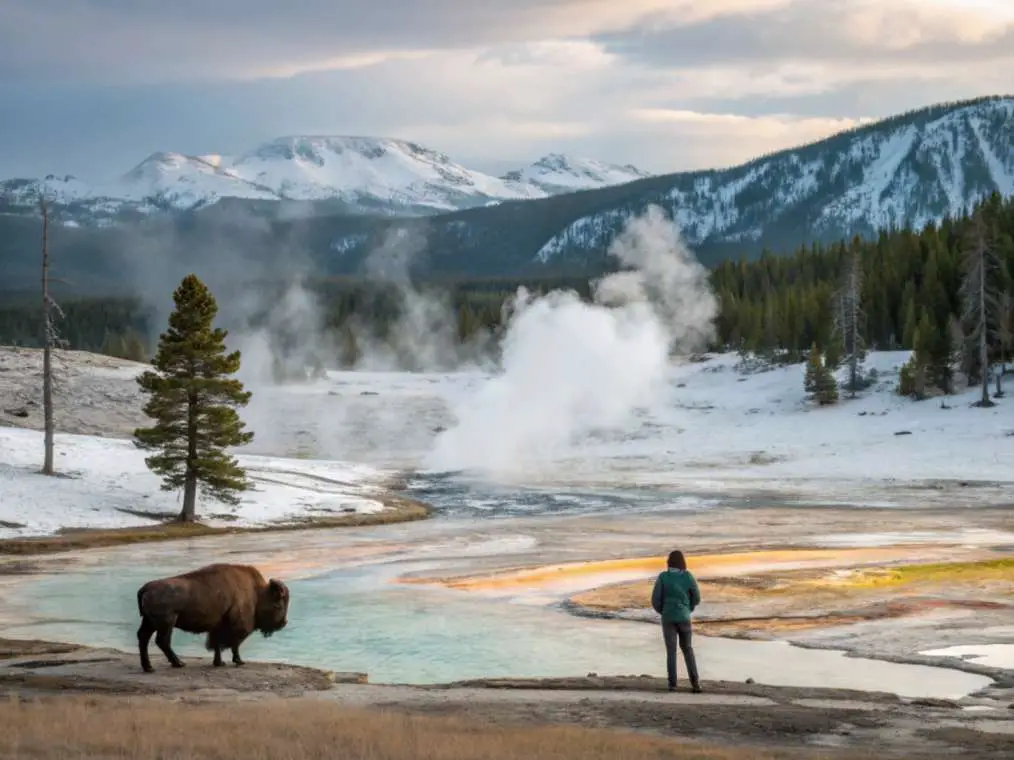
Yellowstone National Park is a top spot for solo travelers. It has huge landscapes and many different ecosystems. This means lots of hiking spots and chances to see wildlife.
The park is easy to get around and has many facilities. This makes it great for people traveling alone.
Solo visitors can dive into Yellowstone’s wonders. Lamar and Hayden Valleys are great for seeing animals like bison and elk. You might even see wolves. The park’s hot springs and geysers, like Old Faithful, offer amazing views and photo chances.
Getting to Yellowstone is easy. Bozeman Yellowstone International Airport is just 90 minutes from the north entrance. Inside the park, a good road system connects all the main sights. This makes exploring simple.
Winter visits are quieter and magical. The snow turns the park into a peaceful place. It’s perfect for quiet walks and thinking.
There are many places to stay, too. The Old Faithful Inn, built in 1904, is a special place to stay. It’s one of the biggest log buildings in the world. It has a big stone fireplace, making it a warm place to rest after exploring.
Exploring the Everglades: A Unique Adventure for Women
The Everglades National Park is a thrilling place for solo female travelers. It covers 1.5 million acres and has nine different ecosystems. This makes it perfect for wildlife encounters and nature lovers.
Wildlife Encounters
The Everglades is home to over 360 bird species, alligators, crocodiles, and the rare Florida panther. You can also see dolphins and small reef sharks in the water. It’s the only place where alligators and crocodiles live together in the wild.
Kayaking and Boating Opportunities
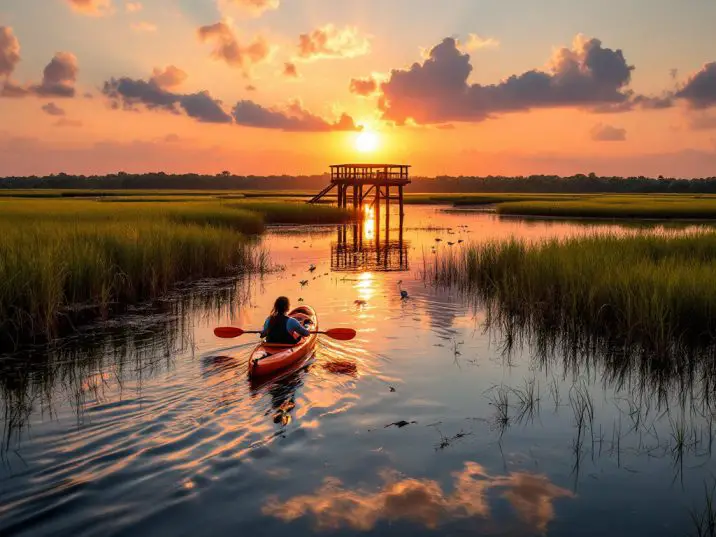
Kayaking is a must for the adventurous. A nine-mile paddle takes you to a chickee platform in Florida Bay for camping. This trip lets you explore the largest continuous sawgrass prairie in North America.
Guided Tours and Programs
The park has many guided tours and educational programs. These help solo travelers have a better experience and stay safe. October is a good time to visit because it’s less crowded.
When planning your trip, look into park accommodation options. The Ernest F. Coe Visitor Center is a great place to start. Some areas might be closed due to weather, so check updates before you go.
Grand Teton National Park: Scenic Beauty and Accessible Trails
Grand Teton National Park is a top spot for solo female travelers who love hiking. It’s less crowded than Yellowstone, offering a peaceful experience. The 42-mile scenic loop is a quick drive, perfect for seeing many beautiful views in one day.
Photography lovers will adore spots like Moose-Wilson Road, Schwabacher Landing, and Mormon Row. The park has trails for everyone, from easy walks to tough hikes. First-timers should plan to stay 3-5 days to see it all.
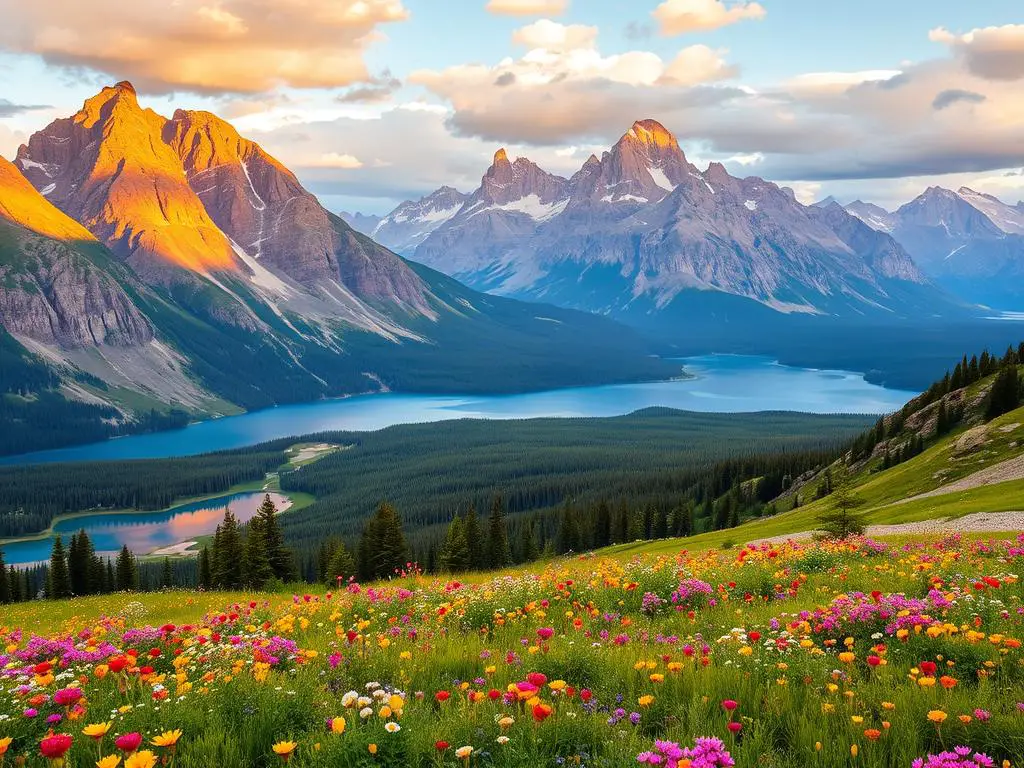
There are many places to stay, from campsites to lodges. The $35 entrance fee lets you in for seven days. But, you can get the $80 America the Beautiful Park Pass for unlimited visits to all U.S. National Parks. Summer is the busiest time, but it’s the best weather for outdoor fun.
Just an hour from Yellowstone, Grand Teton is a great addition to your trip. Its stunning views and wildlife make it safe and beautiful for solo female travelers.
Glacier National Park: Ranger-Led Hikes and Shuttle Services
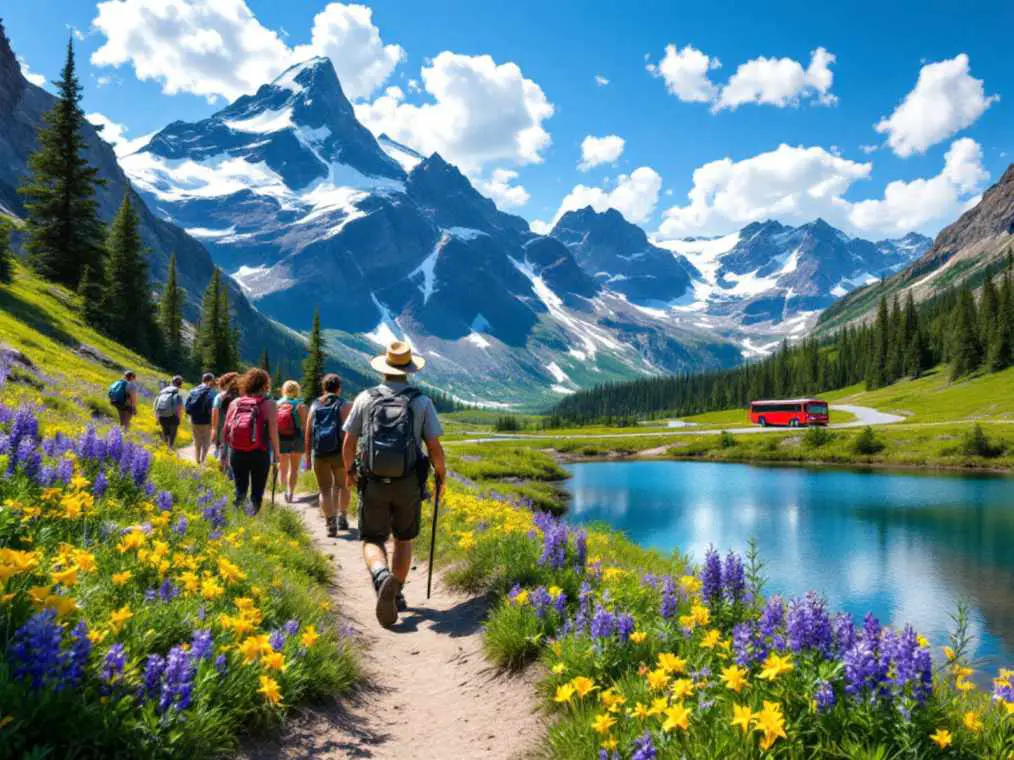
Glacier National Park is a top spot for hiking in America. It welcomes over 3 million visitors each year. This vast wilderness offers amazing outdoor adventures.
Free Educational Programs
Ranger-led hikes are a big draw here. They’re free and teach you about the park’s nature and history. Trails like the Highline Trail and Siyeh Pass Trail offer stunning views for all skill levels.
Transportation Options
A free shuttle runs from July to Labor Day. It helps you see the park’s vast areas. The famous Going-to-the-Sun Road, open from July to September, reaches Logan Pass at 6,646 feet.
This shuttle makes it easy to get to key spots and join ranger-led hikes.
Safety Measures for Solo Hikers
Glacier National Park focuses on keeping visitors safe. With 900 bears, including 300 grizzlies, bear safety is key. You can rent bear spray at various spots.
Stay alert, make noise, and hike in groups when you can. The park’s waterfalls and Lake McDonald are beautiful but need caution.
Entrance fees change with the season and how you get there. Vehicle reservations are needed in peak months. Plan well to enjoy your Glacier National Park trip!
Bryce Canyon: Manageable Size and Stunning Landscapes
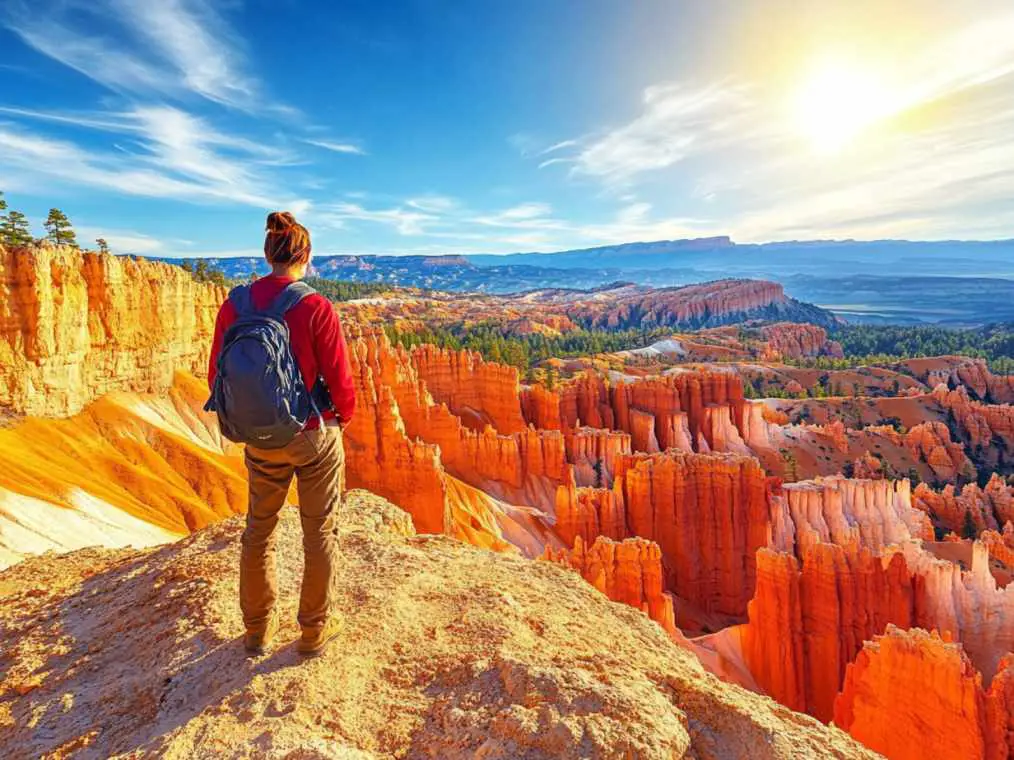
Bryce Canyon National Park was established in 1928. It’s a perfect spot for solo female travelers. Its compact size and well-organized roads make it easy to explore. The park’s high elevation offers stunning views all year.
Bryce Canyon has hiking trails for everyone. The Fairy-tale loop is tough but offers magical views of hoodoos. These rock formations are breathtaking at sunrise and sunset.
For a calm experience, many overlooks are accessible by car. They offer great views without hard hiking. This makes Bryce Canyon perfect for solo travelers who want to enjoy nature at their own pace.
Visiting Bryce Canyon is affordable at just $30 per vehicle or free with an $85 annual pass. You can grab healthy snacks before exploring. The best times to visit are April-May and September-October, when it’s mild and less crowded.
Bryce Canyon is a top pick for solo female travelers. It offers safety and unforgettable outdoor experiences. Its manageable size, stunning landscapes, and variety of activities make it a standout choice.
Best National Parks for Solo Female Travelers
The United States has 63 amazing national parks. Each one offers something special for solo female travelers. These parks are safe, adventurous, and have stunning views. Here are some top picks for hiking and scenic spots perfect for women traveling alone.
Acadia National Park
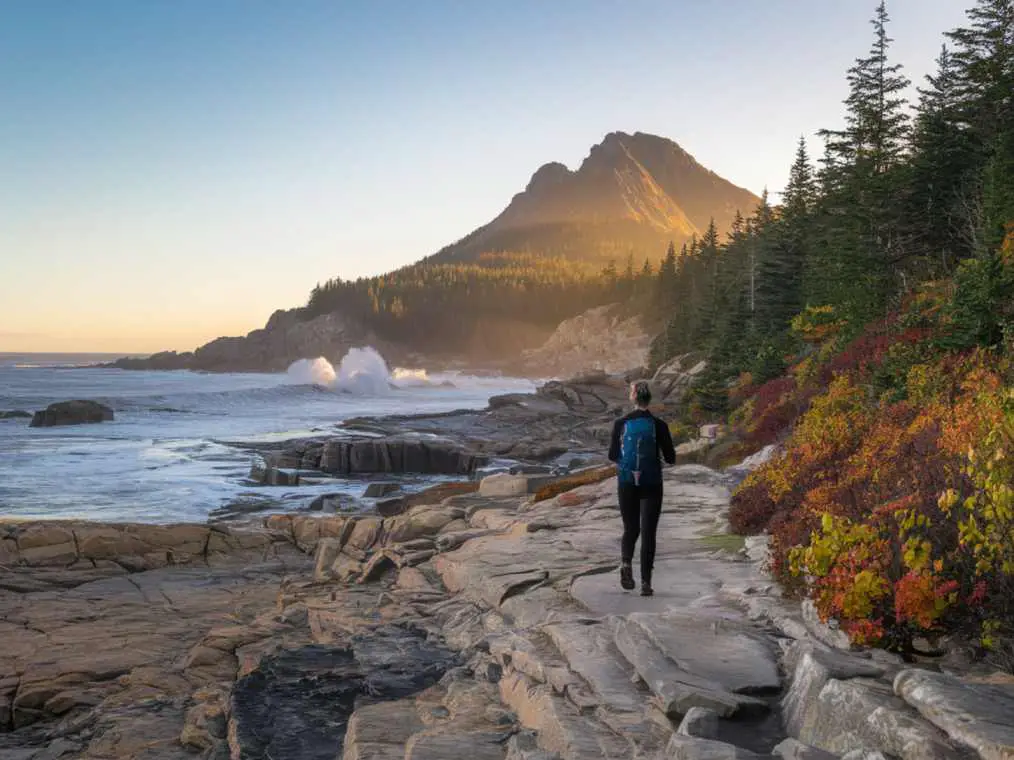
Acadia in Maine is a top choice for solo female travelers. It has everything from rocky beaches to mountain peaks. The park’s trails are well-kept, and there are ranger-led programs for solo hikers. Make sure to see the sunrise from Cadillac Mountain!
Great Smoky Mountains National Park
Great Smoky Mountains is the most visited national park. It has easy day hikes and wildlife to see. The Appalachian Trail section here is great for solo adventurers. The Cades Cove loop offers beautiful views and a chance to see black bears safely.
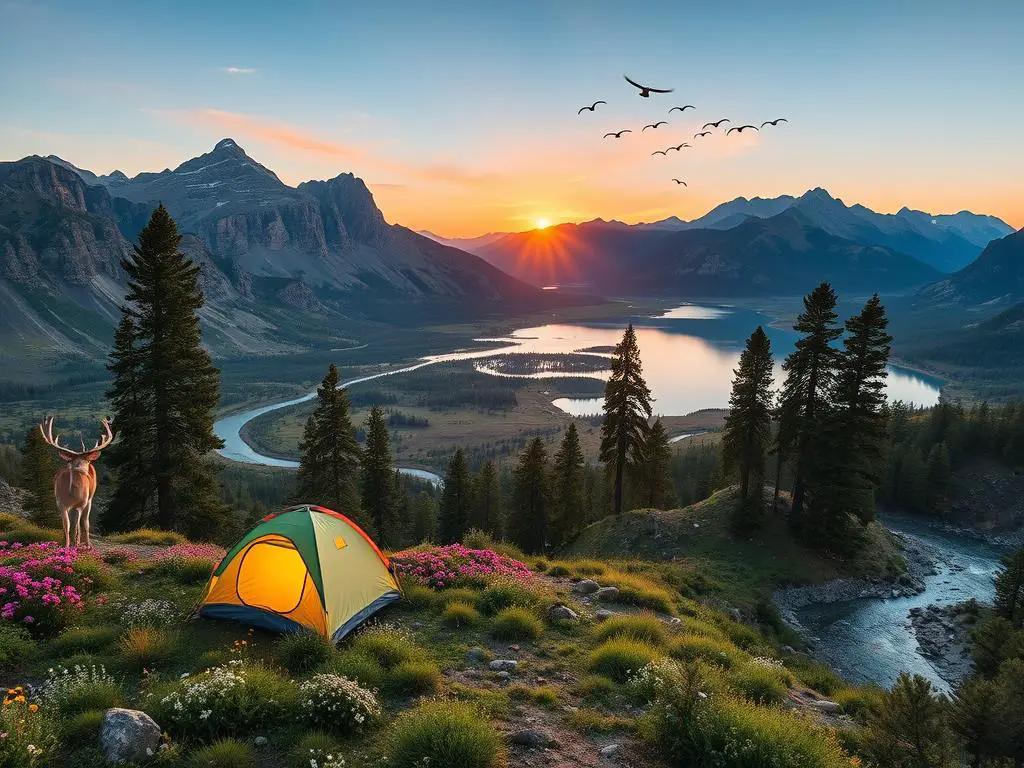
Zion National Park
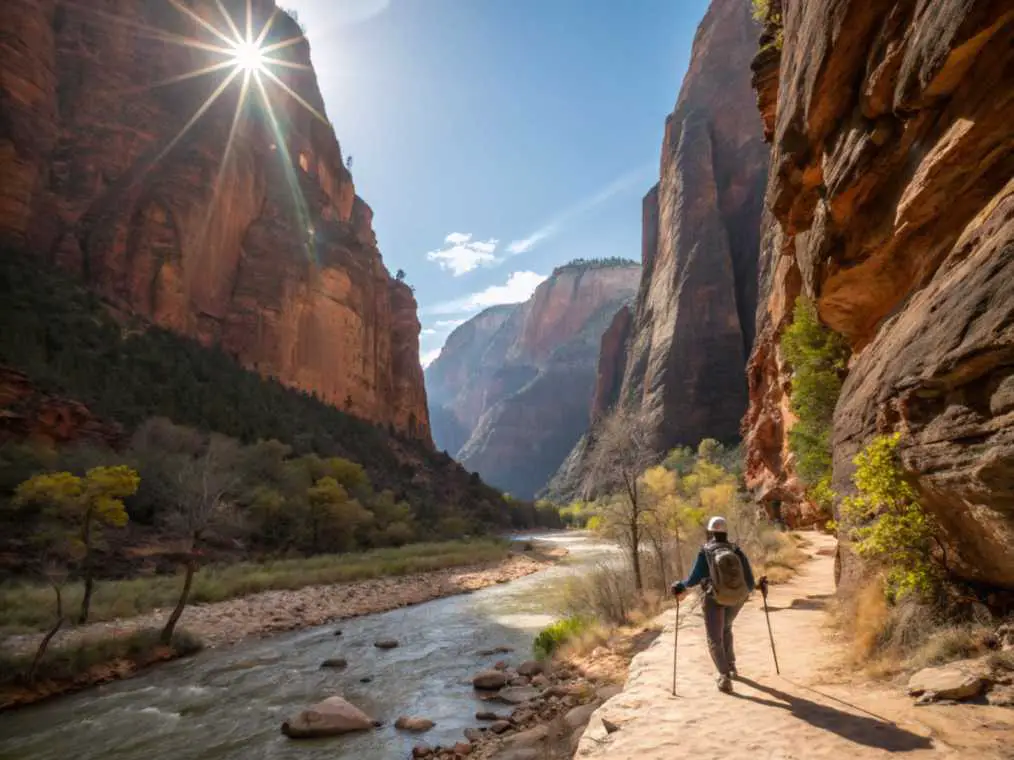
Zion in Utah is a dream for solo female hikers. The park’s shuttle system makes it easy and safe to get around. Famous trails like The Narrows and Angels Landing are thrilling. For a quieter spot, try the Hidden Canyon trail, which has stunning views without the crowds.
National parks are perfect for solo female travelers. They offer a sense of community, safety, and endless growth opportunities. Ranger programs and admission fees help keep these places safe for women to explore alone.
Tips for Planning a Solo National Park Adventure
Planning a solo trip to a national park is exciting and empowering. To ensure a safe and enjoyable journey, consider these tips. First, research the park’s rules and weather. This helps you pack the right gear and clothes for any weather.
Book campsites or lodges in advance if they’re popular. Create a detailed plan and share it with someone you trust. Pack a first aid kit, headlamp, and a satellite device. These are key for safety and emergencies.
Visit park visitor centers for the latest info. Join ranger-led tours to learn more and meet others. Choose places close to your basecamp for easier access and rest.
Invest in good gear for your adventure. You’ll need:
- Food and water
- Warm clothes and blankets
- Portable camp stove
- Battery packs
- Navigation tools
Stay alert and listen to your gut during your trip. Don’t post your exact location on social media for safety. With these tips, you’re ready for a memorable solo national park adventure.
Safety Precautions for Solo Female Travelers in National Parks
National park safety is key for solo female travelers. Exploring outdoors is exciting, but planning ahead keeps you safe. Here are important safety tips for your solo trip.
Ranger Programs and Resources
Park rangers are a big help for solo travelers. Join ranger-led hikes to learn about the park and meet others. Visit ranger stations for trail updates and safety advice. These resources make your outdoor adventure safer and more enjoyable.
Communication Devices and Emergency Plans
Good communication is essential for solo travel. Carry a satellite messenger for places with no cell service. Download maps offline before you go. Tell a trusted friend or family member where you’re headed. Also, pack a first-aid kit and extra meds for emergencies.
Awareness and Self-Defense Techniques
Be mindful of your surroundings during your adventure. Listen to your gut and stay alert. Learning basic self-defense can make you feel more secure. Carry cash and important documents safely. Remember, being prepared is the best way to enjoy a safe solo trip in our beautiful national parks.
- Download offline maps for areas with limited connectivity
- Carry a satellite messenger for emergency communication
- Share your itinerary with a trusted contact
- Pack a first-aid kit and extra medications
- Stay alert and trust your instincts
Read More-
Budget-Friendly Options for Solo Park Visits
Exploring national parks solo doesn’t have to be expensive. With smart planning, you can have a great time without spending a lot. The America the Beautiful Pass is a great deal. It lets you visit over 2,000 federal sites for just $80 a year.
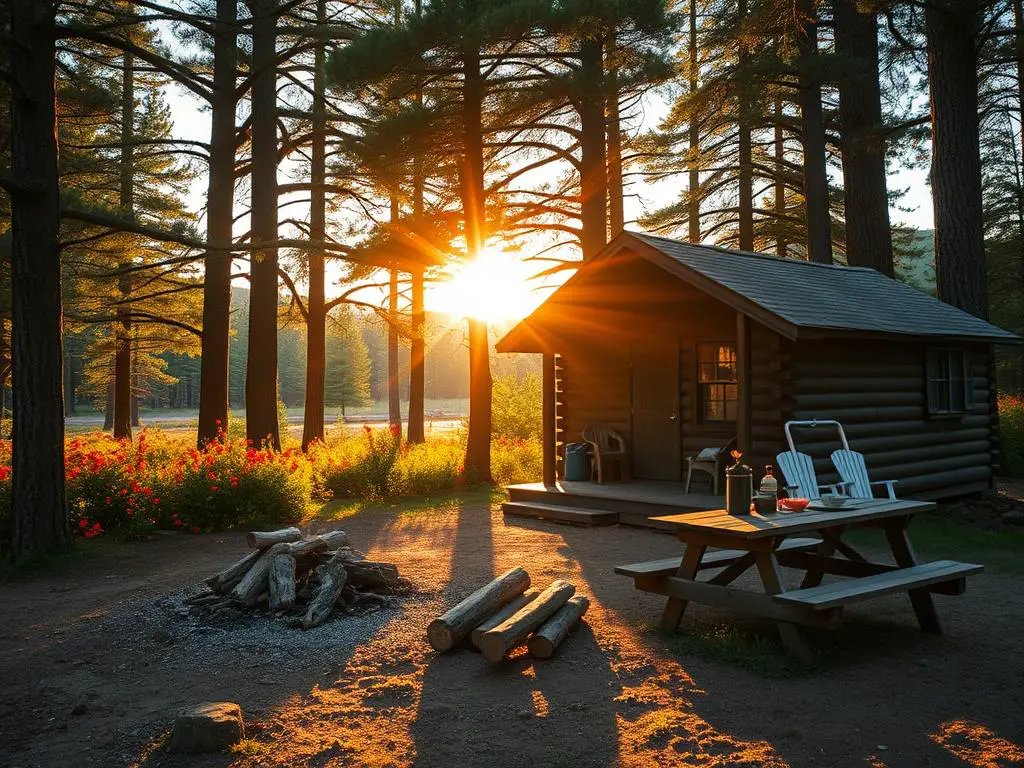
Camping is a great way to save money. Many parks have free or low-cost campsites. For example, Kulanaokuaiki in Hawaii Volcanoes National Park costs only $10 a night. Schoodic Woods in Acadia National Park is just $22 a night.
Solo travel tips for budget-conscious adventurers:
- Pack your own meals instead of dining out
- Visit during off-season for lower accommodation rates
- Take advantage of free ranger-led programs
- Use park shuttle services when available
- Consider sharing transportation or campsites with other solo travelers
Worldpackers offers a chance to trade skills for a place to stay. This can save you a lot of money. Solo travel is about making memories in nature, not just saving money.
Seasonal Considerations for National Park Solo Travel
When planning your solo trip to national parks, think about the season. Each season brings its own special experiences for outdoor lovers and hikers.
Best Times to Visit Popular Parks
Summer is the busiest time, with millions visiting places like Yosemite. For a quieter trip, fall is a great choice. Parks like Great Smoky Mountains are less crowded then, showing off beautiful fall colors.
Off-Season Advantages
Winter offers a unique chance for solo travel. With the right gear, you can explore snow-covered landscapes alone. Yellowstone, for example, is magical in winter. Plus, off-season visits are cheaper and easier to plan.
Weather Preparedness
Spring and fall weather can be unpredictable. Always pack layers and check the forecast. For places like Zion National Park, bring gear for sudden weather changes. Being prepared is essential for a safe and fun solo trip.
- Check park websites for seasonal closures
- Pack appropriate clothing for expected weather
- Carry extra supplies in case of unexpected conditions
By keeping these seasonal tips in mind, you’ll make your solo national park trip even better. Remember, good planning is the key to a safe and unforgettable adventure.
Connecting with Other Solo Travelers in National Parks
National parks are great places for solo travelers to meet others. Ranger-led hikes and campfire programs are perfect for making friends. These activities offer tips and make your camping better.
Park lodges and campgrounds are social spots. With over 50 national parks in the U.S., there’s plenty to explore. Look for meet-up notices on visitor center bulletin boards to connect with others.
Social media groups for national park travel can help plan your trip. You can meet others before you go. Shared shuttle rides and guided tours are great for starting conversations and sharing tips.
At Zion National Park, join a group hike to Observation Point. It’s 8 miles of stunning views. Americans are friendly to tourists, so don’t be shy to talk to others at campsites or on trails.
You might find a hiking buddy or share stories by the campfire. With many solo travelers in national parks, you’re sure to meet friendly people on your journey.
Conclusion
Going solo in America’s national parks is a chance for personal growth and exploring the outdoors. Places like Yellowstone and the Great Smoky Mountains offer something for everyone. Solo female travelers can feel safe with ranger programs and well-kept trails.
The top national parks for solo female travelers have stunning views and good facilities. Parks like Acadia, Zion, and Glacier are great for their trails and educational programs. You can explore all year, staying safe with the right gear.
For a solo trip, share your plans with family, pack light, and get travel insurance. Many solo travelers meet new people, forming a community of adventurers. You can camp or stay in lodges, making your trip your own.
When planning your solo trip, remember national parks are more than beautiful views. They’re a place for self-discovery and connecting with nature. With good planning and an open mind, solo travelers can have amazing experiences and make unforgettable memories.
FAQ
What makes National Parks ideal for solo female travelers?
National Parks are safe with fees, rangers, and visitor centers. They offer free maps and a supportive community. Solo travelers can grow through hikes, wildlife, and nature.
What are the advantages of solo travel in National Parks?
Traveling solo means you can plan your trip your way. You can meet others and join ranger activities. National Parks have many experiences, from drives to hikes, for all.
What essential gear should solo female adventurers bring to National Parks?
Bring safety items like bear spray and a first aid kit. Don’t forget camping and hiking gear, and tools like GPS and a compass. Also, a multi-tool, water filter, and a satellite messenger are key.
What makes Yellowstone National Park a great destination for solo travelers?
Yellowstone has wildlife, geysers, and winter fun. It’s easy to get around with many facilities. It’s perfect for solo travelers.
What unique adventures does the Everglades offer for solo female travelers?
The Everglades has kayaking, alligator sightings, and birdwatching. There’s a bike path for observing wildlife. Guided tours make it safe and fun.
Why is Grand Teton National Park a great option for solo female hikers?
Grand Teton has beautiful mountains and trails for all. The road system makes it easy to find trails. Jackson Hole has dining and places to stay, and skiing in winter.
How does Glacier National Park cater to solo travelers?
Glacier has free hikes and programs for solo travelers. The shuttle system is free. There are bear spray rentals for safety.
What makes Bryce Canyon National Park a manageable destination for solo explorers?
Bryce Canyon is small and easy to navigate. It has many trails and views by car. The hoodoos and sunsets are stunning.
What are some other top National Parks for solo female travelers?
Acadia has diverse landscapes. Great Smoky Mountains has day hikes and wildlife. Zion has iconic hikes and a shuttle system.
What tips should solo female travelers follow when planning a National Park adventure?
Research park rules and weather. Make reservations and plan your trip. Pack for changing weather and use park resources.
What safety precautions should solo female travelers take in National Parks?
Join ranger programs and use park resources. Carry a reliable device and have an emergency plan. Stay alert and know basic self-defense.
How can solo travelers visit National Parks on a budget?
Buy an America the Beautiful Pass for many visits. Use free campsites and cook your meals. Visit in the off-season for lower costs.
What seasonal considerations should solo travelers keep in mind for National Park visits?
Summer is busy but has full access. Spring and fall are mild with fewer visitors. Winter is quiet but prepare for weather. Off-season is cheaper but unpredictable.
How can solo travelers connect with others during their National Park adventures?
Join ranger hikes and campfire programs. Stay in lodges or campgrounds. Use visitor centers and social media groups to meet others.
